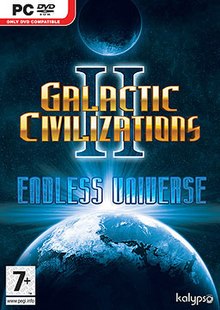Galactic Civilizations II: Dread Lords
Stardock also opted for a rather unusual distribution strategy that lacks copy prevention, and allowed for extensive modding by the community.
[1] A powerful, highly advanced civilization, remembered in legend as the "Precursors", colonized much of the galaxy thousands of years ago.
As younger specimens throughout the galaxy began to develop the beginnings of their own primitive civilizations, it led to a philosophical rift within Precursor society, splitting it into two factions.
Human scientists realized that, with the inclusion of a fusion power source, the technology behind the stargates could be modified to create a hyperdrive engine.
The player must guide Humanity's actions as they attempt to prevent Precursor technology from being discovered by their enemies, fight a galactic war between the major powers and survive the onslaught of the genocidal Dread Lords.
The game is played in what is known as a "sandbox" galaxy mode, where the objective is to achieve victory over AI opponents in one of four ways - military conquest, cultural domination, universal alliance or technological supremacy.
Minor civilizations (which do not factor into winning conditions, and have a weaker AI), such as the sentient rodent-like Snathi, can also appear in the game.
Every ship is designed around a particular class of hull - tiny, small, cargo, medium, large and huge - and has a predetermined number of hit points and capacity.
Each component may be added multiple times with summing effect; a player could create a fast long-range fighter with two lasers, two ion engines, a support module, and a shield.
A wide variety of non-functional components ("jewelry") such as wings, pylons, wheel structures, and lights may be added for artistic purposes.
Players may zoom out to view the galactic map on a wide scale, at which point the ships, planets and anomalies are replaced by icons.
A major focus of Galactic Civilizations II is the artificial intelligence of its opponents, due in part to the deliberate omission of multiplayer in favor of the single-player experience.
Galactic Civilizations II adds another layer of complexity by requiring that the income of an empire is used to pay for all forms of production.
At random times throughout the game, though commonly in colonizing new planets, the player is presented with ethical choices in the form of events where a wide-ranging decision needs to be made.
For example, one random event involves the creation of a super-serum that can enhance soldiers' performance at the expense of decreasing the life expectancy of those who take it.
The player may forbid its use and destroy all of the research at government's expense (good), only allow it to be used by those who volunteer (neutral), or require all army recruits to take it (evil).
Others are more benign, with all civilizations experiencing a short-term economic boom, or a "wave of xenophobia" (usually triggered by prolonged warfare) that halts tourism.
The United Planets does not usually have a great effect on the game, but some of the propositions — for example, the transfer of unique researched technologies, or the imposition of a certain governmental system — can be extremely destabilizing if passed.
They wrote, "Galactic Civilizations II may not lead to a resurgence of space conquest games, but as long as it's available, the renaissance can wait.
"[9] Ten days after its launch, Galactic Civilizations II had matched the lifetime sales of its predecessor by that time, with 75,000 copies sold.
[10] According to Stardock's CEO Brad Wardell, as of March 2008, Galactic Civilizations II has sold around 300,000 copies in total, bringing in an eight-figure revenue, on a development budget of less than $1 million.
[11] Stardock has not instituted any stringent or cumbersome copy prevention schemes in accordance with what its CEO Wardell has defined as the Gamer's Bill of Rights.
Stardock's anti-piracy plan is that players must complete product activation with a valid serial number before they may receive any of the several game updates.
Serial numbers can be used multiple times and the company owner, Brad Wardell, has stated that they are taking an approach based on the view that people who install the game illegally were unlikely to purchase it anyway.
On November 21, 2015 "Galactic Civilizations II: Ultimate Edition" was released DRM-free and without product activation on the digital distribution website gog.com.
[13] On March 5, 2006, a StarForce employee publicly posted a working link[14] to a BitTorrent search engine listing of Galactic Civilizations II torrents during a discussion about the popularity of the game.
[16] Stardock also posted an article,[17] partially in response to inaccurate reporting of their own reasons for releasing the game without copy protection.
Starforce later closed the thread, posting an apology and stating that the employee "just wanted to show that every non-protected game can be cracked".
[22] Galactic Civilizations II: Endless Universe is a compilation featuring the content of Dread Lords, Dark Avatar and Twilight of the Arnor.
The ship designs are also intended to be redistributed to others, and popular models (both derivative and original) appeared shortly after the game's release.


